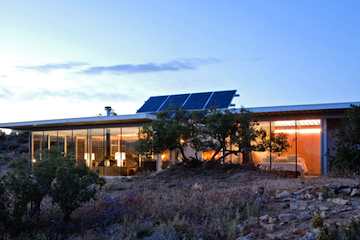
They have features like heavily insulated walls, wastewater-recovery systems and passive heating; one home has a wind turbine on the roof. Prefabrication minimizes waste (since unused materials stay at the factory instead of being thrown away) and can save time and money. One Oregon homeowner in the book says that his 2,300-square-foot prefab home cost less than $900,000. Estimates to build a similar house on site were more than double that.
In Joshua Tree National Park, a Pioneertown, Calif., house— equipped with solar panels and a 2,500-gallon water tank—is completely off the grid. The overhanging roof blocks the high sun in the summer, but allows the lower sun in during the winter. A ceiling-mounted fireplace adds heat on cold days. Cost to build: $265,000.
Energy-saving features in a Belfast, Maine, home include an insulated concrete foundation, concrete floors (which absorb heat during the day and release it at night) and triple-glazed windows. Cost to build: no more than $150 a square foot, or about $225,000. Estimated annual heating and cooling cost: $300.
A crane lifted the modules for this 2,039-square-foot Chicago home onto the foundation in a day. Cost to build: $200 a square foot, or about $408,000.
A Chapel Hill, N.C., house is sited with the front door square to the sun at solar noon every day, to make the most of natural light. The earth around the ground floor was excavated to bring in more sun. As a certified Passive House, it is highly insulated; a ventilator system ensures fresh air inside the house. Average heating bill last winter: $35 a month.